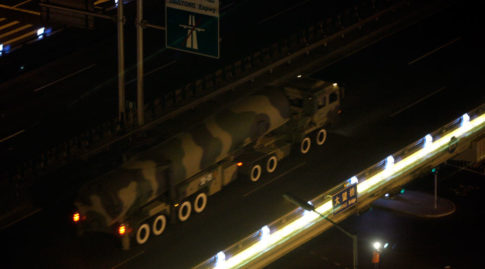– China Deploys ICBM System “In Response To Trump’s Provocative Remarks”:
China is wasting no time to project power in a world in which it believes Donald Trump’s “America First” doctrine has created a “superpower vacuum.”
One day after a senior Chinese diplomat said on Monday that Beijing is prepared to “assume a role of world leadership if others step back from that position” after U.S. President Donald Trump pledged in his first speech to put “America first”, Beijing has reportedly deployed an advanced Dongfeng-41 ICBM system in Heilongjiang Province, which borders with Russia.
According to China’s nationalist Global Times tabloid, “the Chinese military intentionally revealed the Dongfeng-41 and connected it with the inauguration of US President Donald Trump. They think this is Beijing’s response to Trump’s provocative remarks on China.”
The Global Times added that “pictures of China’s Dongfeng-41 ballistic missile were exposed on Chinese mainland websites,” citing reports in “some Hong Kong and Taiwan media.” One of the reports was identified as the Apple Daily, another tabloid-style resource based ot of Hong Kong, according to RT. “It was revealed that the pictures were taken in Heilongjiang Province. Military analysts believe that this is perhaps the second Dongfeng-41 strategic missile brigade and it should be deployed in northeastern China,” the report in the Chinese newspaper notes.
The Dongfeng-41 is a nuclear solid-fuel road-mobile intercontinental ballistic missile. With a range of 15,000 kilometers and a payload of 10-12 nuclear warheads, it can target anywhere in the world and is widely considered one of the most advanced intercontinental ballistic missiles. China has yet to reveal the ICBM to the general public during a military parade or any similar event. Most information of the advanced weapon remains highly classified.
There has been speculation that China plans to deploy at least three brigades of DF-41s throughout the country. According to the Global Times, the image was purposefully leaked to coincide with Trump’s inauguration, in light of the US president’s confrontational stance towards China. Earlier today, China’s foreign ministry responded to comments by White House speaker Sean Spicer, urging the US to “act and speak cautiously” when it comes to the disputed South China Seas to “avoid harming the peace and stability” in the region.
China routinely uses demonstration of its military prowess to send signals to challengers like the US. For instance, it tested a railcar-launched version of the DF-41 in December 2016 just as then-Defense Secretary Ashton Carter visited the aircraft carrier ‘USS John C. Stennis’ deployed in the South China Sea.
Meanwhile, Russia has welcomed the placement of China’s ICBM next to its border, saying it is not an indication of threat toward China’s northern neighbor.
The alleged deployment of the DF-41 near Russia’s border should not be read as a threat to Russia, military analyst Konstantin Sivkov told RIA Novosti.
“DF-41 missiles placed near Russia’s border are a smaller threat than if they were placed deeper in the Chinese territory. Such missiles usually have a very large ‘dead zone’ [area within minimal range that cannot be attacked by a weapon],” he said, adding that the ICBMs would not be able to target Russia’s Far East and most of Eastern Siberia from the Heilongjiang Province.
The Kremlin agreed with the assessment, saying that China is Russia’s “strategic partner in political and economic senses.”
“Certainly, the actions of the Chinese military, if the reports prove correct, the military build-up in China is not perceived as a threat to our country,” said Kremlin spokesman Dmitry Peskov.
It is, however, perceived as a threat to the US, and nowhere was that made more clear than in China’s own wording.
As the Global Times added, “the US has the world’s most powerful military strength, including the most advanced and powerful nuclear arsenal. But Trump has called for a nuclear arms build-up many times. Even Washington feels that its naval forces and nuclear strength are lacking, so how can China be content with its current nuclear strength when it is viewed by the US as its biggest potential opponent?”
The Global Times then notes that “China’s nuclear capability should be so strong that no country would dare launch a military showdown with China under any circumstance, and such that China can strike back against those militarily provoking it. A military clash with the US is the last thing China wants, but China’s nuclear arsenal must be able to deter the US.”
The dangerous tone continued throughout the article:
The US has not paid enough respect to China’s military. Senior US officials of the Asia-Pacific command frequently show their intention to flex their muscles with arrogance. The Trump team also took a flippant attitude toward China’s core interests after Trump’s election win. Enhancing communication and mutual understanding is not enough. China must procure a level of strategic military strength that will force the US to respect it.
A China with or without the Dongfeng-41 is different to the outside world. That is the significance of the Dongfeng-41. We hope this strategic edge will be revealed officially soon. It will not bring the China Threat theory, but will only add authority to the People’s Liberation Army.
While Trump has had a busy morning, dismantling Obama’s (and Warren Buffett’s) anti- Keystone pipeline legacy, and has hardly caught up with the latest news out of China, we are curious how the US president will react – either on Twitter or otherwise – to the knowledge that what until now was a diplomatic “war of words”, has not so quietly spilled over into what appears to be another nuclear build up arms race.
* * *
PayPal: Donate in USD
PayPal: Donate in EUR
PayPal: Donate in GBP
